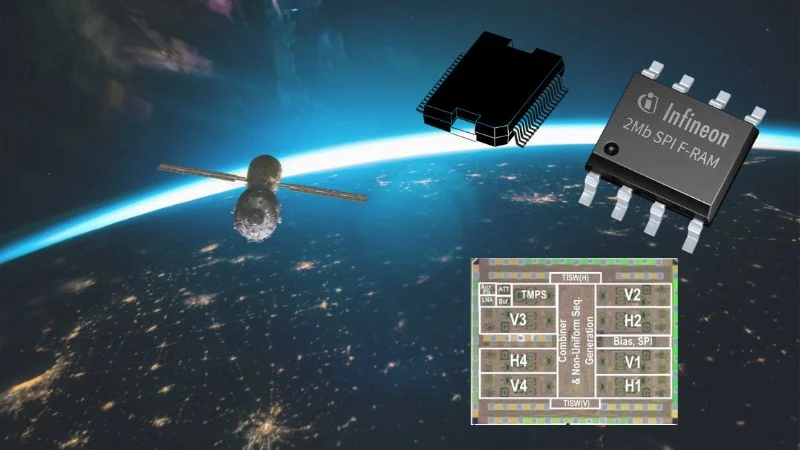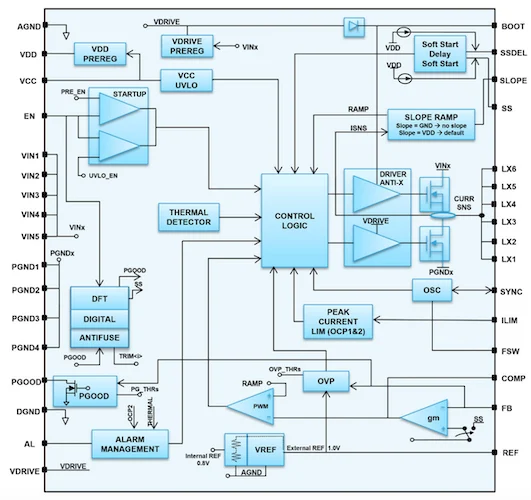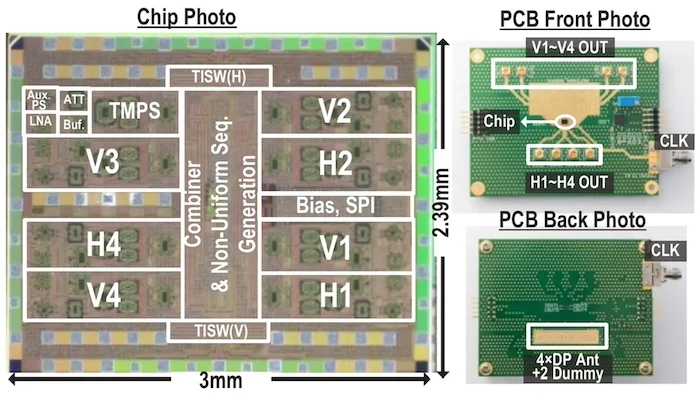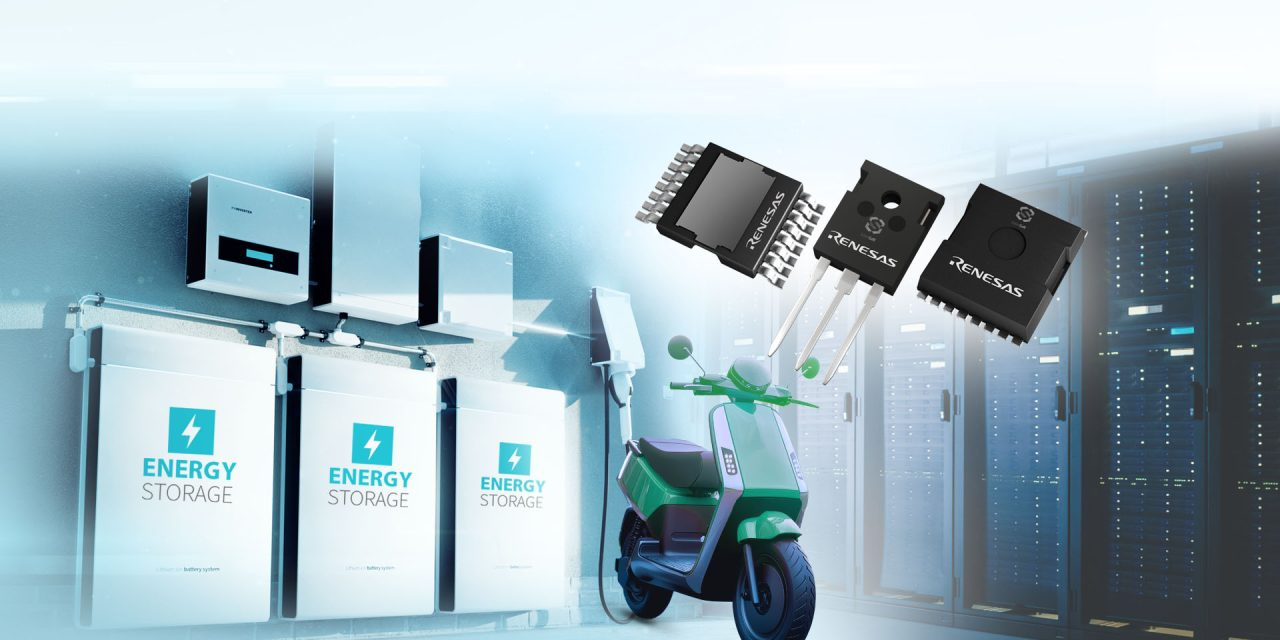As satellite constellations in low Earth orbit grow in scale and ambition, the demand for robust, compact, and cost-effective electronic components continues to rise.
As the “NewSpace” sector accelerates, engineers face mounting pressure to design hardware that balances performance, reliability, and radiation tolerance for low Earth orbit (LEO) environments.

This round-up highlights three recent developments advancing that goal: Infineon’s new portfolio of radiation-tolerant memory tailored for satellite constellations, STMicroelectronics’ point-of-load converter optimized for LEO power systems, and a record-setting MIMO receiver architecture from the Institute of Science Tokyo poised to reshape 6G satellite communications.
Infineon’s Radiation-Tolerant Memory for LEO Satellites
Infineon Technologies has announced a new portfolio of radiation-tolerant memory components designed for the expanding NewSpace market, where cost-effective, high-reliability solutions are critical for LEO satellite constellations. These satellites, often smaller and shorter-lived than traditional geostationary platforms, demand components that balance performance with reduced size, weight, and power consumption (SWaP). Infineon’s memory offerings are built to meet these requirements while tolerating the radiation environment typical of LEO missions.

Infineon’s NewSpace memory portfolio includes three product families: low-power, radiation-tolerant F-RAMs, QSPI NOR flash, and pSRAMs. Image used courtesy of Infineon
The new memory lineup includes three product families: Ferroelectric RAM (F-RAM), QSPI NOR Flash, and pseudo-static RAM (pSRAM). The F-RAM devices offer non-volatile storage with ultra-low power and high endurance, capable of operating from -55°C to +125°C and tolerating total ionizing doses (TID) up to 50 krad(Si).
For code storage and execution, the NOR Flash series supports 256 Mbit and 512 Mbit densities, operates between -40°C and +125°C, and is rated for 30 krad(Si) TID. Meanwhile, Infineon’s pSRAM, which internally behaves like DRAM but provides an SRAM-compatible interface, is designed for high-throughput buffering applications. These are the first pSRAMs specifically positioned for the NewSpace market. They are accordingly rated at 100 krad(Si) and are notable for their low pin count and high-speed operation.
ST’s Rad-Hard PoL Converter for LEO Spacecraft
STMicroelectronics has released the LEOPOL1, a radiation-hardened, monolithic point-of-load (PoL) DC-DC converter tailored for power management in low Earth orbit (LEO) spacecraft. Part of ST’s expanding portfolio for the NewSpace sector, the LEOPOL1 (datasheet linked) leverages space-grade silicon-on-insulator (BCD6-SOI) technology and is hardened by design to withstand key radiation challenges of LEO environments, making it particularly attractive for satellite OEMs seeking a cost-effective alternative to traditional hermetic packaging.
The device can deliver up to 7 A in ground-level (non-radiative) conditions and up to 5 A in harsh radiation environments (up to 62 MeV·cm²/mg), with stable operation from 3 V to 12 V input. It features a fully integrated synchronous buck topology with internal power MOSFETs and supports programmable output voltages from 0.8 V up to 85% of VIN. Designed to meet a 50 krad(Si) total ionizing dose (TID), the LEOPOL1 is also single-event latch-up (SEL)-free at LET levels up to 62 MeV·cm²/mg and immune to non-ionizing energy loss (TNID) at 3×10¹¹ protons/cm², ensuring mission reliability over multi-year LEO lifespans.

Block diagram of the LEOPOL1. Image used courtesy of STMicroelectronics
Beyond its radiation resilience, the LEOPOL1 offers several advanced features: configurable soft-start, current sharing via out-of-phase synchronization, full protection (OVP, OCP, OTP, UVLO), and real-time Power Good signaling. Its flexible interleaving and master/slave synchronization allow multiple units to be combined for scalable current delivery in multi-rail systems, such as FPGAs and onboard computing platforms.
The LEOPOL1 is qualified under ST’s proprietary LEO-grade specification (derived from AEC-Q100), offering an optimized balance between reliability, cost, and production scalability for the commercial space market.
New MIMO Accelerates Phased-Array Receivers for 6G LEO Satellites
In a significant advance for next-generation satellite communications, researchers at the Institute of Science Tokyo have demonstrated a novel time-division MIMO (Multiple-Input Multiple-Output) system optimized for low Earth orbit (LEO) satellite platforms and future 6G networks. Unlike conventional spatial MIMO architectures, which scale poorly with the number of antennas due to increasing circuit complexity, the team’s design introduces a non-uniform time-hopping approach to efficiently reuse signal paths across MIMO streams.

These images depict the receiver developed in the study, which was implemented in a small integrated circuit and mounted on a printed circuit board for testing purposes. Image used courtesy of the Institute of Science Tokyo
This new method dramatically reduces the silicon area and power requirements by eliminating the need for a dedicated receiver chain per antenna-stream combination. Instead, fast switching circuits dynamically reroute signal paths through shared hardware, allowing eight data streams to be demultiplexed with high fidelity from a single chip. The prototype receiver, built in 65-nm CMOS, operates at 3.2 GHz and integrates high-speed phase shifters and synchronized switches to handle both horizontal and vertical polarizations in a 4 × 4 MIMO configuration.
The result is an impressive 38.4 Gbps throughput, representing a record for millimeter-wave phased-array MIMO receivers, achieved with minimal area and power consumption. These innovations position the technology as a strong candidate for integration into compact satellite transceivers, mobile devices, and Internet of Things (IoT) endpoints supporting hybrid terrestrial/non-terrestrial 5G and 6G communications.



